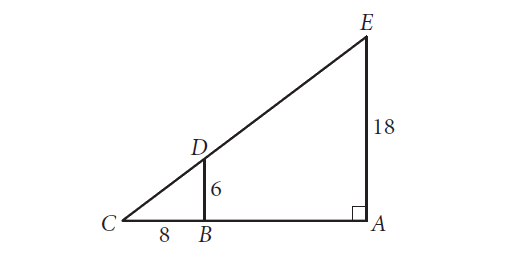
In the figure above, ¯¯¯¯¯¯BD is parallel to ¯¯¯¯¯¯AE. What is the length of ¯¯¯¯¯¯CE ?
The correct Answer is:C
In the figure given , since ¯¯¯¯¯¯BD is parallel to ¯¯¯¯¯¯AE are both segments are intersected by ¯¯¯¯¯¯CE , then angle BDC and angle BDC and angle AEC are corresponding angles and therefore congruent. Angle BCD and angle ACE are similar because if two angles of one triangle are congruent to two angles of another triangle , the triangles are similar . Since triangles BCD and triangle ACE are similar, their corresponding sides are proportional . So in triangle BCD and triangle ACE , ¯¯¯¯¯¯BD corresponds to ¯¯¯¯¯¯AE and ¯¯¯¯¯¯CD corresponds to ¯¯¯¯¯¯CE . Therefore BDCD=AECE . Since triangle BCD is a right triangle , the Pythagorean theorem can be used to give the value of CD : 62+82=CD2. Taking the square root of each side gives CD=10. Substituting the values in the proportion BDCD=AECE yields 610=18CE . Multiplying each side by CE, and then multiplying by 106 yields CE = 30. Therefore , the length of ¯¯¯¯¯¯CE is 30.
Similar Questions
The inequation represented by the graph given below is :
View SolutionThe inequation that best describes the graph given below is _________
View SolutionThe inequation that best describes the following graph is _________
View SolutionIn the following figure, if O is the center of the circle and ¯¯¯¯¯¯AB is the diameter, then find ∠ACB.
ltimg src="https://d10lpgp6xz60nq.cloudfront.net/physics_images/PS_MATH_IX_C12_E02_009_Q01.png" width="80%"gt
View SolutionIn the following figure, ¯¯¯¯¯¯BD is produced to E. If ¯¯¯¯¯¯AD is the angle bisector of ∠A, then find the ∠BCD.
ltimg src="https://d10lpgp6xz60nq.cloudfront.net/physics_images/PS_MATH_IX_C12_E03_005_Q01.png" width="80%"gt
View SolutionIn the given figure, ¯¯¯¯¯¯AD and ¯¯¯¯¯¯BE intersect at C, such that BC = CE, ∠ABC=40∘ and ∠DEC=85∘. Find ∠BAC−∠CDE.
ltimg src="https://d10lpgp6xz60nq.cloudfront.net/physics_images/PS_MATH_IX_C12_E04_027_Q01.png" width="80%"gt
View SolutionIn the given figure, PQRS is a parallelogram. A and B are the mid-point of ¯¯¯¯¯¯PQ and ¯¯¯¯¯SR respectively. If PS=BR, then the quadrilateral ADBC is a…………………… ,
ltimg src="https://d10lpgp6xz60nq.cloudfront.net/physics_images/PS_MATH_IX_C12_E05_020_Q01.png" width="80%"gt
View SolutionWhat is the distance OA for the square shown in figure :- ltimg src="https://d10lpgp6xz60nq.cloudfront.net/physics_images/ALN_PHY_R05_E01_015_Q01.png" width="80%"gt
View Solution
